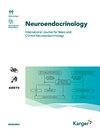全身联合使用低剂量催产素和胰高血糖素样肽-1,可降低食物摄入量和体重。
IF 3.2
2区 医学
Q2 ENDOCRINOLOGY & METABOLISM
引用次数: 0
摘要
引言 GLP-1 受体激动剂是治疗肥胖症和 2 型糖尿病的头号药物。然而,这些药物并非没有副作用,为了最大限度地提高治疗效果,同时最大限度地减少不良反应,肠道激素共拮抗剂作为对抗肥胖症的新药物靶点受到了广泛关注。之前的许多报道都认为神经肽催产素(OXT)是一种很有前景的抗肥胖药物。本研究旨在评估 OXT 作为 GLP-1 拮抗剂的可能性,并研究其联合给药对小鼠食物摄入量(FI)和体重(BW)的影响。方法在腹腔注射生理盐水、OXT、GLP-1 或 OXT/GLP-1 后,测量大脑摄食中心的 FI 和 c-Fos 水平。在体外 PVN 神经元培养物中测量了对 OXT、GLP-1 或 OXT/GLP-1 反应的动作电位频率和细胞膜 Ca2+ ([Ca2+]i)。最后,比较了用生理盐水、OXT、GLP-1 或 OXT/GLP-1 治疗 13 天的饮食诱导肥胖小鼠的 FI 和体重变化。PVN中70%的GLP-1受体阳性神经元也表达OXT受体,OXT/GLP-1联合给药显著增加了PVN OXT神经元的发射和[Ca2+]i。结论 长期服用 OXT/GLP-1 可降低体重,但不改变 FI。OXT可能是治疗肥胖症的一种增量素联合激动剂。本文章由计算机程序翻译,如有差异,请以英文原文为准。
Systemic co-administration of low dose oxytocin and glucagon like peptide-1 additively decreases food intake and body weight.
INTRODUCTION
GLP-1 receptor agonists are the number one drug prescribed for the treatment of obesity and type 2 diabetes. These drugs are not, however, without side-effects and in an effort to maximize therapeutic effect while minimizing adverse effects, gut hormone co-agonists received considerable attention as new drug targets in the fight against obesity. Numerous previous reports identified the neuropeptide oxytocin (OXT) as a promising anti-obesity drug. The aim of this study is to evaluate OXT as a possible co-agonist for GLP-1 and examine the effects of its co-administration on food intake (FI) and body weight (BW) in mice.
METHODS
FI and c-Fos levels were measured in the feeding-centers of the brain in response to an intraperitoneal injection of saline, OXT, GLP-1 or OXT/GLP-1. The action potential frequency and cytosolic Ca2+ ([Ca2+]i) in response to OXT, GLP-1 or OXT/GLP-1were measured in ex-vivo PVN neuronal cultures. Finally, FI and BW changes were compared in diet induced obese mice treated with saline, OXT, GLP-1 or OXT/GLP-1 for 13 days.
RESULTS
Single injection of OXT/GLP-1 additively decreased FI, and increased c-Fos expression specifically in the paraventricular (PVN) and supraoptic nucleus (SON). 70% of GLP-1 receptor positive neurons in the PVN also expressed OXT receptors, and OXT/GLP-1 co-administration dramatically increased firing and [Ca2+]i in the PVN OXT neurons. The chronic OXT/GLP-1 co-administration decreased BW without changing FI.
CONCLUSION
Chronic OXT/GLP-1 co-administration decreases BW, possibly via the activation of PVN OXT neurons. OXT might be a promising candidate as an incretin co-agonist in obesity treatment.
求助全文
通过发布文献求助,成功后即可免费获取论文全文。
去求助
来源期刊

Neuroendocrinology
医学-内分泌学与代谢
CiteScore
8.30
自引率
2.40%
发文量
50
审稿时长
6-12 weeks
期刊介绍:
''Neuroendocrinology'' publishes papers reporting original research in basic and clinical neuroendocrinology. The journal explores the complex interactions between neuronal networks and endocrine glands (in some instances also immunecells) in both central and peripheral nervous systems. Original contributions cover all aspects of the field, from molecular and cellular neuroendocrinology, physiology, pharmacology, and the neuroanatomy of neuroendocrine systems to neuroendocrine correlates of behaviour, clinical neuroendocrinology and neuroendocrine cancers. Readers also benefit from reviews by noted experts, which highlight especially active areas of current research, and special focus editions of topical interest.
 求助内容:
求助内容: 应助结果提醒方式:
应助结果提醒方式:


